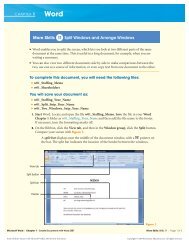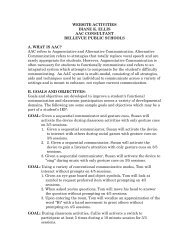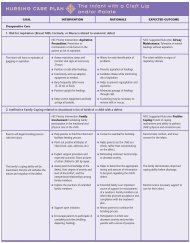launching a successful online business and ec projects - Prentice Hall
launching a successful online business and ec projects - Prentice Hall
launching a successful online business and ec projects - Prentice Hall
You also want an ePaper? Increase the reach of your titles
YUMPU automatically turns print PDFs into web optimized ePapers that Google loves.
Chapter Twelve: Launching a Successful Online Business <strong>and</strong> EC Proj<strong>ec</strong>ts W12.5<br />
met before starting <strong>and</strong> operating a <strong>business</strong>. For more information, see microsoft.<br />
com/small<strong>business</strong>/startup-toolkit.<br />
One of the major steps in <strong>launching</strong> any start-up is to find a viable product (service).<br />
This may take a long time, b<strong>ec</strong>ause the concept comes first, followed by a prototype, <strong>and</strong><br />
then a market test. Also, finding the corr<strong>ec</strong>t <strong>business</strong> model is critical (see Chapter 1 <strong>and</strong><br />
the Online Tutorial).<br />
Umesh et al. (2005) provide some interesting guidelines to avoid dot-com failures.<br />
Sp<strong>ec</strong>ifically, they suggest looking at: (1) the growth rate of the intended market, (2) the<br />
timing of market entry, (3) revenue flow, <strong>and</strong> (4) what part of the cycle a market is in. For<br />
a free 14-session guide to starting a <strong>business</strong>, see myown<strong>business</strong>.org/course_list.html.<br />
CREATING A NEW COMPANY OR ADDING AN ONLINE PROJECT<br />
In Chapter 1, we described the case of Zappos where an interesting idea <strong>and</strong> strategy led to<br />
a very <strong>successful</strong> <strong>online</strong> company. Most new <strong>business</strong>es—brick-<strong>and</strong>-mortar, pure-play, or<br />
click-<strong>and</strong>-mortar—begin in a similar manner.The following three steps describe the process:<br />
1. Identify a consumer or <strong>business</strong> need in the marketplace. Many <strong>business</strong>es simply<br />
begin with a good idea. A magazine article, a personal observation, an unsolved<br />
problem, a small irritation, or a friend’s suggestion may trigger an idea, <strong>and</strong> the<br />
prosp<strong>ec</strong>tive <strong>business</strong> owner sees a gap between what people want <strong>and</strong> what is available.<br />
For an example, see Case 12.1 (p. 12-6). Note that the key here is innovation.<br />
2. Investigate the opportunity. Just b<strong>ec</strong>ause a person perceives that an opportunity exists<br />
does not mean that it is real. Perhaps the potential number of individuals interested in<br />
purchasing the proposed product or service is too small. Perhaps the cost of manufacturing,<br />
marketing, <strong>and</strong> distributing the product or providing the service is too large.The revenue<br />
model may be wrong, others may have tried already <strong>and</strong> failed, satisfactory<br />
substitute products may be available, <strong>and</strong> so on. For example, <strong>online</strong> grocery<br />
shopping would seem like a wonderful opportunity—relieving busy professionals of the<br />
time-consuming <strong>and</strong> tiresome task of regular visits to a grocery store. Many have tried to<br />
provide large- <strong>and</strong> small-scale <strong>online</strong> grocery ventures (e.g., Netgrocer, Peapod,<br />
HomeGrocer, Webvan), but most have failed or continue to lose money b<strong>ec</strong>ause they<br />
misjudged the logistical problems associated with grocery warehousing <strong>and</strong> delivery.This<br />
is why it is so important to develop a <strong>business</strong> plan. One of the purposes of a <strong>business</strong> plan<br />
is to determine the feasibility <strong>and</strong> viability of a <strong>business</strong> opportunity in the marketplace.<br />
3. Determine the <strong>business</strong> owner’s ability to meet the need. Assuming that a realistic<br />
<strong>business</strong> opportunity exists, does the prosp<strong>ec</strong>tive <strong>business</strong> owner have the ability to convert<br />
the opportunity into success? Some personal qualities are important: Is the <strong>business</strong><br />
in an industry the prosp<strong>ec</strong>tive <strong>business</strong> owner knows well? Is it something the entrepreneur<br />
loves doing? Are family <strong>and</strong> friends supportive? Business skills in staff r<strong>ec</strong>ruitment,<br />
management, negotiation, marketing, <strong>and</strong> financial management are required, as well as<br />
entrepreneurial attitudes such as innovation, risk taking, <strong>and</strong> being proactive. Many good<br />
ideas <strong>and</strong> realistic initiatives have failed in the ex<strong>ec</strong>ution stage b<strong>ec</strong>ause the owners or<br />
other principals of the <strong>business</strong> lacked sufficient <strong>business</strong> skills to make it a reality.<br />
Boo.com, for example, seemingly had a great concept (retailing ultramodern, designer<br />
clothing) <strong>and</strong> superior software, but it failed b<strong>ec</strong>ause of the inability of management to<br />
organize the <strong>business</strong> <strong>and</strong> manage the proj<strong>ec</strong>ts n<strong>ec</strong>essary to bring Boo.com <strong>online</strong> before<br />
it burned through $120 million of start-up capital (Cukier 2000).<br />
The process for developing EC proj<strong>ec</strong>ts in existing companies is similar to that of<br />
starting a new <strong>business</strong>, except that step 3, just mentioned, changes to: “Determine the<br />
organization’s ability to meet the need.”

















